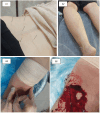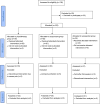Comparative efficacy of acupuncture, venesection, and physical therapy on chronic low back pain outcomes: a randomized clinical trial
- PMID: 38694293
- PMCID: PMC11060228
- DOI: 10.1097/MS9.0000000000001944
Comparative efficacy of acupuncture, venesection, and physical therapy on chronic low back pain outcomes: a randomized clinical trial
Abstract
Objective: Chronic low back pain (CLBP) imposes considerable financial and social burden with poor response to medical and surgical treatments. Alternatively, acupuncture and venesection(Fasd) are traditionally used to alleviate nociceptive and musculoskeletal pains. This study aimed to evaluate the effectiveness and the safety of acupuncture and venesection on CLBP and patient functionality.
Methods: The current study was a single-blinded, randomized clinical trial with balanced allocation, conducted in the Department of Physical Medicine & Rehabilitation Medicine, in 2022. One hundred five CLBP patients who had no back pain-attributable structural or major diseases were randomly allocated into three parallel arms and received either physical therapy (PTG), acupuncture (APG), or venesection (VSG). Pain severity and functional aspects were evaluated using the visual analogue scale (VAS) and Oswestry disability index (ODI) during the study. VAS and ODI scores were defined as the primary outcomes.
Results: Ninety-five patients were reviewed in the final analysis (PTG=33, APG=30, VSG=31). Demographic data showed equal group distribution. Statistical analysis showed all procedures had reduced VAS score immediately after the first session, after the last session, and after follow-up; however, APG and VSG values were significantly lower (P<0.05). Pain reduction results in follow-up period were more sustainable in APG and VSG as compared to PTG (P<0.01). ODI results revealed global improvement after the last session of the treatment in all groups, while APG had more significant results (P<0.05). During the follow-up period, ODI still tended to decrease in VSG, non-significantly increased in APG, and significantly increased in PTG. Only two patients reported fainting after receiving venesection.
Conclusion: Considering the pain and functional scores, both acupuncture and venesection can reproduce reliable results. Acupuncture and venesection both have sustained effects on pain and daily function of the patients even after treatment termination, while physical therapy had more relapse in pain and functional limitations.
Keywords: Acupuncture; chronic low back pain; oswestry disability index; physical therapy modalities; traditional chinese medicine; traditional persian medicine; venesection.
Copyright © 2024 The Author(s). Published by Wolters Kluwer Health, Inc.
Conflict of interest statement
None.Sponsorships or competing interests that may be relevant to content are disclosed at the end of this article.
Figures





Similar articles
-
Acupuncture for chronic low back pain: a multicenter, randomized, patient-assessor blind, sham-controlled clinical trial.Spine (Phila Pa 1976). 2013 Apr 1;38(7):549-57. doi: 10.1097/BRS.0b013e318275e601. Spine (Phila Pa 1976). 2013. PMID: 23026870 Clinical Trial.
-
Complementary and alternative therapies for back pain II.Evid Rep Technol Assess (Full Rep). 2010 Oct;(194):1-764. Evid Rep Technol Assess (Full Rep). 2010. PMID: 23126534 Free PMC article. Review.
-
Comparison of Different Treatment Regimens of Extracorporeal Shockwave Therapy in Chronic Low-back Pain: A Randomized Controlled Trial.Pain Physician. 2022 Nov;25(8):E1211-E1218. Pain Physician. 2022. PMID: 36375191 Clinical Trial.
-
Motion style acupuncture treatment (MSAT) for acute low back pain with severe disability: a multicenter, randomized, controlled trial protocol.BMC Complement Altern Med. 2011 Dec 13;11:127. doi: 10.1186/1472-6882-11-127. BMC Complement Altern Med. 2011. PMID: 22151475 Free PMC article. Clinical Trial.
-
Meta-analysis of the efficacy of acupuncture in the treatment of low back fasciitis.Am J Transl Res. 2023 Aug 15;15(8):5486-5494. eCollection 2023. Am J Transl Res. 2023. PMID: 37692963 Free PMC article. Review.
References
-
- Ohnmeiss DD, Rashbaum RF. Patient satisfaction with spinal cord stimulation for predominant complaints of chronic, intractable low back pain. Spine J 2001;1:358–363. - PubMed
-
- Godfrey E, Wileman V, Holmes MG, et al. . Physical therapy informed by acceptance and commitment therapy (PACT) versus usual care physical therapy for adults with chronic low back pain: a randomized controlled trial. J Pain 2020;21:71–81. - PubMed
LinkOut - more resources
Full Text Sources
